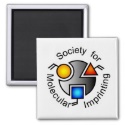|
|
Reference type: Journal
Authors: Matsunaga T, Hishiya T, Takeuchi T
Article Title: Surface plasmon resonance sensor for lysozyme based on molecularly imprinted thin films.
Publication date: 2007
Journal: Analytica Chimica Acta
Volume: 591
Issue: (1)
Page numbers: 63-67.
DOI: 10.1016/j.aca.2007.02.072
Alternative URL: http://www.sciencedirect.com/science/article/B6TF4-4N7SBS3-2/2/82cc239968260cdc8cc97ae50480aa61
Abstract: Molecularly imprinted polymers (MIPs) selective for lysozyme were prepared on SPR sensor chips by radical co-polymerization with acrylic acid and N,N'-methylenebisacrylamide. Gold-coated SPR sensor chips were modified with N,N'-bis(acryloyl)cystamine, on which MIP thin films were covalently conjugated. The presence of NaCl during the polymerization and the re-binding tests affected the selectivity and the optimization of NaCl concentration in the pre-polymerization mixture and the re-binding buffer could enhance the selectivity in the target protein sensing. When the lysozyme-imprinted polymer thin films were prepared in the presence of 40 mM NaCl, the selectivity factor (target protein bound/reference protein bound) of MIP in the re-binding buffer containing 20 mM NaCl was 9.8, meanwhile, that of MIP in the re-binding buffer without NaCl was 1.2. A combination of SPR sensing technology with protein-imprinted thin films is a promising tool for the construction of selective protein sensors
Template and target information: protein, lysozyme
Author keywords: molecular imprinting, protein recognition, lysozyme, surface plasmon resonance sensor, acrylic acid, N,N'-Methylenebisacrylamide
|


 MI cryptic logo iphone3 speckcase
MI cryptic logo iphone3 speckcase







 SMI magnet white
SMI magnet white







 SMI logo hat
SMI logo hat






